As the morning sun rises over Colombia, the smell of breakfast wafts through the air. I grew up watching my grandmother make delicious arepas. She turned simple ingredients into a feast that celebrated our culture.
Colombian breakfast is more than food. It’s a way to show off regional diversity and creativity. From the coast to the mountains, each area adds its own flavor to breakfast. These recipes connect us to family, tradition, and the amazing flavors of Colombian cuisine.
Colombian breakfast is more than just breakfast. Arepas, a staple, come in many forms across the country. Each arepa tells a story of local ingredients, family recipes, and Colombian hospitality.
Key Takeaways
- Colombian breakfast celebrates regional culinary diversity
- Arepas are a fundamental component of morning meals
- Breakfast is a significant cultural experience in Colombia
- Traditional recipes blend sweet and savory flavors
- Each dish reflects local ingredients and cooking techniques
Understanding Traditional Colombian Breakfast Culture
Colombian breakfast is more than just a meal. It’s a vibrant cultural experience that shows the country’s rich culinary heritage. Exploring Colombian breakfast traditions reveals a world of flavors, warmth, and community that starts early in the morning.
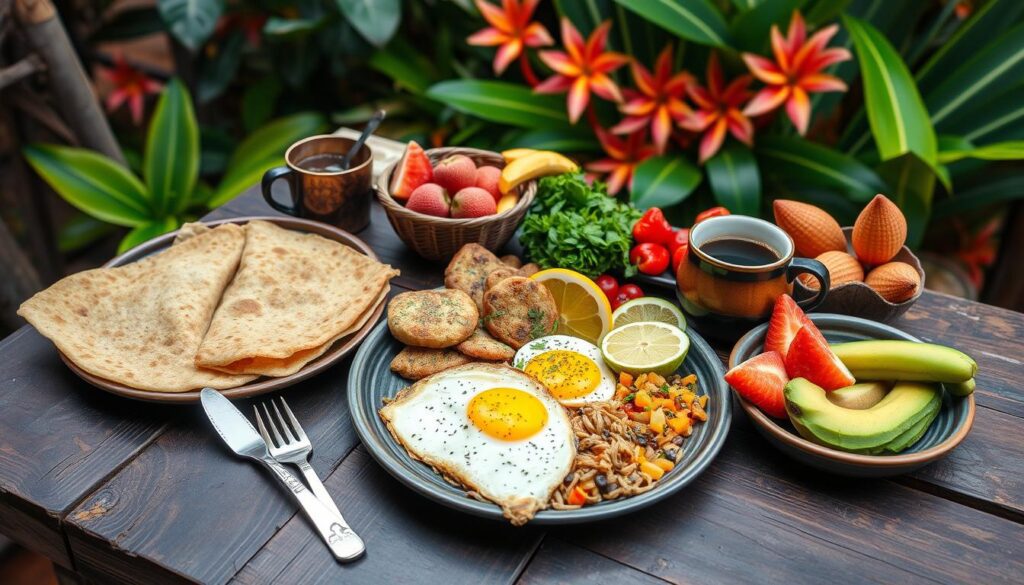
The breakfast landscape in Colombia varies dramatically across different regions. Each region offers unique culinary expressions that tell a story of local ingredients and cultural influences.
Regional Breakfast Variations Across Colombia
Colombian breakfast diversity is remarkable. Different regions showcase distinct breakfast styles:
- Coastal regions feature seafood-inspired dishes
- Andean highlands emphasize hearty, protein-rich meals
- Tropical areas incorporate more fresh fruits and tropical ingredients
The Role of Hot Beverages in Colombian Breakfast
Colombian coffee and hot chocolate are essential to the morning ritual. Colombian coffee, known worldwide for its exceptional quality, is served strong and rich. Traditional hot chocolate, made with panela (raw sugar cane) and sometimes spiced with cinnamon, provides a comforting warmth.
Traditional Breakfast Times and Customs
Colombians typically enjoy breakfast between 6:30 and 8:00 AM. The meal is considered the most important of the day, often featuring substantial items like arepas, eggs, and fresh cheese. Breakfast is a social experience, frequently shared with family or colleagues.
By understanding these breakfast traditions, you’ll gain insight into the heart of Colombian culinary culture. It’s a celebration of food, family, and community.
Essential Ingredients for Colombian Breakfast Dishes
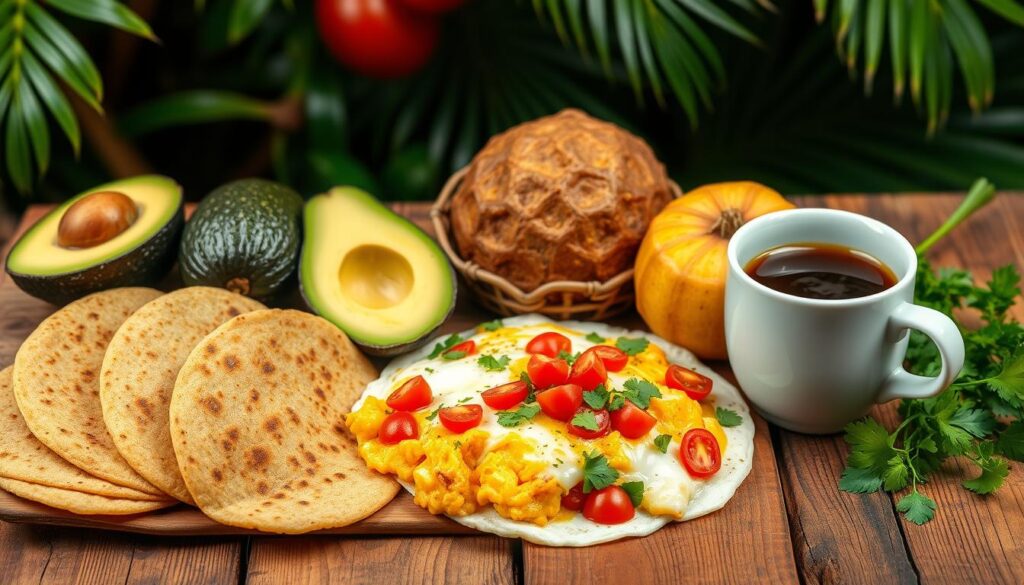
Colombian breakfasts are filled with vibrant flavors and hearty ingredients. Arepas for breakfast are a key part of Colombian cuisine. They show the country’s love for corn-based dishes.
Traditional Colombian morning meals start with essential ingredients. Let’s explore what makes these breakfasts unique:
- Corn Meal (Masa): The heart of arepas and many other breakfast staples
- Fresh Cheeses (Queso Fresco)
- Eggs prepared in various styles
- Tropical Fruits
- Plantains
Corn is a big part of Colombian breakfasts. White and yellow corn meals make arepas that can be stuffed, grilled, or served as a side. Each region has its own arepa style, like:
| Arepa Type | Key Characteristics |
|---|---|
| Arepa Boyacense | Yellow corn flour with cheese curd |
| Arepa con Queso | Extra melted cheese filling |
| Traditional White Corn Arepa | Simple, versatile base for multiple toppings |
Fresh cheeses add a special taste to Colombian breakfasts. Queso fresco and soft white cheeses go well with eggs, arepas, and more. Tropical fruits like papaya, mango, and banana make the meal fresh and healthy.
Mastering the Perfect Arepa con Quesito
Arepas for breakfast are a delightful Colombian culinary tradition. They bring warmth and flavor to your morning meal. These versatile corn cakes are more than just a side dish – they’re a cultural experience waiting to be savored.
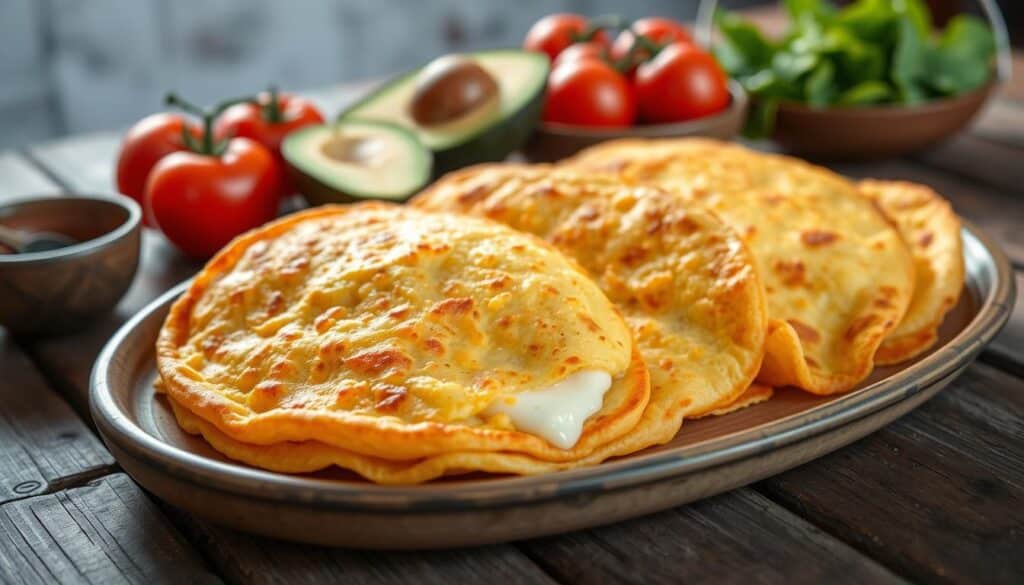
Creating the perfect arepas requires attention to detail and understanding of traditional techniques. Let’s explore the art of making authentic Colombian arepas. They will transform your breakfast routine.
Choosing the Right Corn Meal
Selecting high-quality corn meal is key for delicious arepas. Look for masarepa, a specially processed corn flour. It ensures the right texture and flavor. The recommended ratio includes:
- 2 cups of white cornmeal
- 1 teaspoon of salt
- 2 cups of warm water
- 1 cup of fresh cheese (quesito)
- 3 tablespoons of butter
Proper Arepa Cooking Techniques
Cooking arepas requires precision. Each arepa takes about 3-4 minutes per side on a hot skillet or griddle. Your goal is achieving a golden-brown exterior with a soft, warm interior.
Serving Suggestions and Toppings
Arepas offer endless customization possibilities. Popular toppings include fresh cheese, shredded chicken, beef, or beans. One recipe typically yields 6 delicious arepas, perfect for sharing.
| Nutritional Content (Per Arepa) | Value |
|---|---|
| Calories | 349 kcal |
| Protein | 19 g |
| Carbohydrates | 24 g |
| Fat | 20 g |
Remember, arepas are best enjoyed fresh but can be stored in an airtight container for 1-2 days. Experiment with your favorite toppings and make your breakfast truly memorable!
Colombian Breakfast Recipes: From Simple to Elaborate
Colombian breakfast recipes take you on a tasty journey. You can enjoy quick bites or elaborate feasts. Whether you want a simple huevos perico or a complex dish, there’s something for everyone.
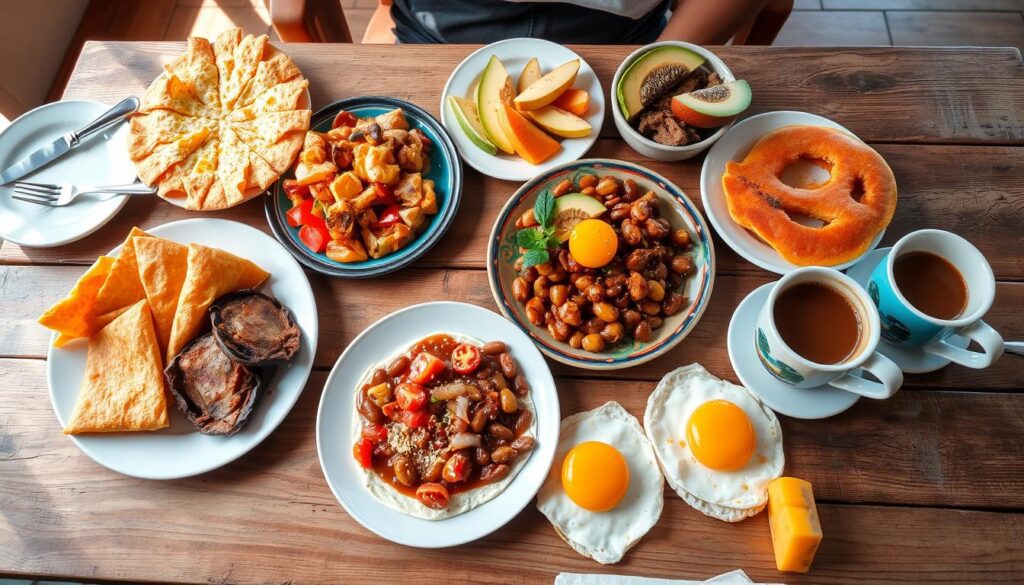
Turn your morning meal into something special with Colombian dishes. These recipes show off the country’s rich culture and varied tastes.
- Simple Breakfast Options
- Arepas with cheese
- Huevos perico (scrambled eggs)
- Fresh tropical fruits
- Elaborate Breakfast Dishes
- Calentado (rice and beans mix)
- Tamales
- Changua (milk and egg soup)
Exploring Colombian breakfasts, you’ll find different prep times. Some dishes are ready in 10-20 minutes. Others need more time and effort.
| Dish Complexity | Prep Time | Cooking Time | Servings |
|---|---|---|---|
| Simple Huevos Perico | 10 minutes | 10 minutes | 4 servings |
| Elaborate Tamales | 1-2 hours | 45-60 minutes | 6-8 servings |
Discovering Colombian breakfasts reveals the cuisine’s depth and creativity. From quick street food to big weekend meals, there’s always a tasty choice.
Huevos Pericos: Colombian-Style Scrambled Eggs
Colombian breakfasts are special thanks to huevos perico. This dish turns simple ingredients into a tasty morning meal. It brings the bright flavors of Colombia to your breakfast.
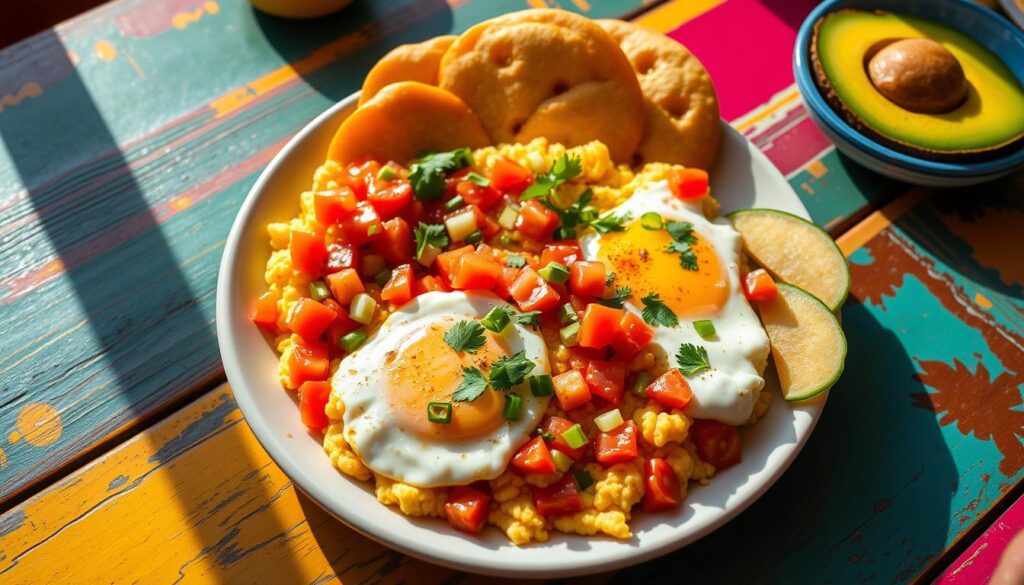
Huevos pericos are more than a quick breakfast. They show the heart of Colombian cooking. They mix fresh ingredients with simple cooking methods.
Key Ingredients for Authentic Taste
- 8 large eggs
- 2-3 scallions, finely chopped
- 2 ripe roma tomatoes, diced
- 1 tablespoon unsalted butter
- Salt and pepper to taste
Step-by-Step Preparation Guide
- Finely chop scallions and dice tomatoes
- Melt butter in a non-stick skillet over medium heat
- Sauté tomatoes and scallions for 2-3 minutes
- Whisk eggs with salt and pepper
- Pour eggs into the skillet with vegetables
- Gently scramble for 5 minutes until eggs are soft and fluffy
| Nutritional Information | Per Serving |
|---|---|
| Calories | 201 kcal |
| Protein | 12g |
| Total Fat | 16g |
| Carbohydrates | 3g |
Enjoy your huevos perico hot with arepas or toast. This breakfast is packed with protein and brings real Colombian flavor to start your day.
Calentado: The Ultimate Comfort Breakfast
Calentado is a standout in Colombian breakfasts. It turns last night’s dinner into a tasty morning meal. This dish shows the clever use of leftover rice and beans, making a filling breakfast.
Calentado is more than a meal; it’s a tradition in Colombian culture. It comes from the Andean region. It’s about making something tasty from leftovers, showing respect for food.
Key Ingredients for Authentic Calentado
- Leftover white rice
- Leftover red or black beans
- Fried egg
- Fresh arepa
- Optional plantains
- Chopped onions
- Fresh herbs for garnish
Making calentado is easy. Just reheat rice and beans in a pan until crispy. Add a fried egg and serve with a warm arepa. Its simplicity and flavor make it special.
Quick Preparation Tips
- Ensure rice and beans are thoroughly reheated
- Fry the egg to your preferred doneness
- Warm the arepa until slightly crispy
- Garnish with fresh herbs
Nearly 80% of Colombian restaurants worldwide offer calentado. It’s a beloved breakfast that also helps reduce food waste. It connects you to Colombian culinary traditions.
Preparing Traditional Colombian Hot Chocolate
Colombian hot chocolate is a beloved part of Colombian breakfasts. It’s more than a drink; it’s a cultural tradition that brings families together. Its unique taste and preparation make it special.
To make authentic Colombian hot chocolate, you need the right tools. The chocolatera (a traditional metal pot) and molinillo (wooden whisk) are key. They help create the perfect texture and froth.
Selecting Premium Chocolate and Spices
High-quality ingredients are essential for great Colombian hot chocolate. Here’s what you need:
- 100% pure Colombian cocoa
- Whole milk (4 ½ cups)
- Bittersweet chocolate (5 ounces)
- Ground cinnamon
- Sugar to taste
Traditional Preparation Techniques
The traditional method involves simmering ingredients carefully. A molinillo is used to create a frothy texture. Bogotá residents love the chocolate Santafereño style, which includes mozzarella cheese cubes.
| Nutritional Information | Per Serving |
|---|---|
| Calories | 399 |
| Carbohydrates | 39g |
| Protein | 11g |
| Total Fat | 22g |
In places like Pereira, Colombian hot chocolate is as common as coffee. It’s a big part of daily life. The careful preparation keeps its nutrients intact.
Changua: The Bogotá Breakfast Soup
Discover changua, a unique Colombian breakfast recipe that warms the heart of Bogotá’s culinary traditions. This milk-based soup is more than a morning meal. It’s a cultural experience deeply rooted in the Andean region’s breakfast practices.
Changua comes from the mountainous departments of Santander, Boyacá, and Cundinamarca. It offers a comforting start to your day. Bogotá, at 8,660 feet above sea level, makes this soup perfect for chilly mornings.
Ingredients for Authentic Changua
- 3 cups of milk
- 1 cup of water
- 2 green onions
- 2 tablespoons of cilantro
- 4 eggs
- 150 grams of white cheese
- 3 slices of toasted bread
Nutritional Profile
| Nutrient | Per Serving |
|---|---|
| Calories | 213 kcal |
| Protein | 14g |
| Carbohydrates | 12g |
| Total Fat | 12g |
Making changua is easy. Start by simmering milk and water with green onions. Then, crack eggs into the liquid and cook for about 3 minutes. The whites should be set, but the yolks should be slightly runny. Finish with fresh cilantro and serve with toasted bread.
Colombian breakfast recipes like changua show the region’s culinary creativity. Families often add potatoes, different cheeses like cuajada, or serve with traditional breads such as almojábanas.
Looking for a nutritious breakfast or wanting to explore Colombian cuisine? Changua is a delightful glimpse into Bogotá’s food culture. Its versatility and comforting nature make it a beloved morning staple across the Andean region.
Tamales Colombianos for Special Breakfasts
Colombian tamales are a beloved dish in Colombian breakfasts. They are more than food; they are a tradition tied to celebrations and family.
Making Colombian tamales is a task that needs skill and time. First, you make a soft corn dough (masa). Then, choose your fillings, which vary by region in Colombia.
- Traditional tamales usually have chicken or pork
- Vegetarian options are getting more popular
- Banana leaves are key for authentic wrapping
Different regions in Colombia offer unique tamale flavors. In Tolima, tamales might have rice and potatoes. Antioquia’s tamales could have different meats and spices.
| Region | Typical Tamales Ingredients | Cooking Time |
|---|---|---|
| Tolima | Chicken, rice, potatoes | 60-75 minutes |
| Antioquia | Pork, corn, herbs | 50-65 minutes |
| Bogotá | Mixed meats, vegetables | 55-70 minutes |
When making tamales at home, remember that patience is key. It takes about an hour to cook, making the masa tender and the flavors rich.
Your homemade Colombian tamales can make any breakfast special. They bring authentic Colombian flavors right to your table.
Conclusion
Colombian breakfasts are more than just food; they connect families and cultures. Exploring these dishes, you’ll find a world of flavors and traditions. They turn simple ingredients into amazing meals.
Every Colombian breakfast has its own story. From calentado to arepas, these dishes show the variety of Colombian food. They highlight the importance of sharing meals with family and friends.
Trying Colombian breakfast recipes brings a piece of South America into your home. You can make huevos pericos, enjoy tropical fruits, or brew Colombian coffee. These dishes offer a real taste of Colombia’s food culture.
Discovering Colombian breakfast will change your mornings. You’ll enjoy dishes that are not only tasty but also rich in culture and nutrition. It’s more than just breakfast; it’s a journey into a world of flavors.
FAQ
What are the most popular Colombian breakfast dishes?
Colombian breakfasts often include arepas, huevos pericos, and calentado. You’ll also find changua and tamales. These dishes highlight the variety of Colombian breakfasts.
How do I make authentic Colombian arepas?
To make arepas, mix pre-cooked corn meal, salt, and water. Shape into patties and cook until golden. Serve with cheese or eggs.
What makes Colombian hot chocolate different?
Colombian hot chocolate is special because it’s made with a chocolatera and molinillo. It uses high-quality chocolate and can have spices like cinnamon.
What is calentado, and why is it popular?
Calentado is a mix of reheated leftovers like rice, beans, and meat. It’s a comfort food that shows Colombian resourcefulness and flavor.
Are Colombian breakfasts typically heavy or light?
Colombian breakfasts are often hearty. They include arepas, calentado, and sometimes eggs. This provides energy for the day.
What role does coffee play in a Colombian breakfast?
Coffee is key in Colombian breakfasts. It’s strong and black or with milk. Enjoying coffee is a big part of Colombian culture.
How do I make huevos pericos?
Scramble eggs with tomatoes and green onions. Sauté the veggies, then add eggs. Cook until soft. Serve with arepas or bread.
Are Colombian breakfast dishes difficult to prepare?
Many Colombian dishes are easy to make, like arepas and huevos pericos. While tamales take more time, most recipes are simple and use common ingredients.

